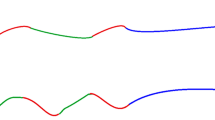Abstract.
The formation of intramolecular micelles in copolymers with periodic sequence, where hydrophobic units (stickers) are periodically placed along the chain, is studied by using multicanonical Monte Carlo computer simulations for an off-lattice bead-rod model in three dimensions. With decreasing the temperature, a transition from random-coil conformations to micelles occurs and flower-type micelles are formed via the transition. The number of stickers forming a micelle core is limited by the excluded-volume effect of loop chains around micelle cores. By this effect, two intramolecular micelles are formed for long polymer chains with 60 bonds via the coil-to-micelle transition. By further decreasing the temperature, we find that another transition, i.e., a micelle-to-micelle transition, takes place. At this transition point, the two intramolecular micelles merge into one micelle. Furthermore, we extend the multicanonical MC method to study elastic properties of single polymer chains with strong attractive interactions under external force fields, and study how the intramolecular micellization affects the elastic property of single polymer chains.
Similar content being viewed by others
References
L.C. McCormick (Editor), Stimuli-Responsive Water Soluble and Amphiphilic Polymers, ACS Symp. Ser., No. 780 (ACS, Washington, DC, 2000).
J.E. Glass (Editor), Associative Polymers in Aqueous Media, ACS Symp. Ser., No. 765 (ACS, Washington, DC, 2000).
S.W. Shalaby, C.L. McCormick, G.B. Butler (Editors), Water-Soluble Polymers: Synthesis, Solution Properties, and Applications, ACS Symp. Ser., No. 467 (ACS, Washington, DC, 1991).
Y. Chang, C.L. McCormick, Macromolecules 26, 6121 (1993)
Y. Morishima, S. Nomura, T. Ikeda, M. Seki, M. Kamachi, Macromolecules 28, 2874 (1995).
B. Xu, L. Lin, K. Zhang, P.M. Macdonald, M.A. Winnik, R. Jenkins, D. Bassett, D. Wolf, O. Nuyken, Langmuir 13, 6896 (1997)
K. Akiyoshi, J. Sunamoto, Supramol. Sci. 3, 157 (1996).
A. Kikuchi, T. Nose, Macromolecules 29, 6770 (1996).
G. Zhang, F.M. Winnik, C. Wu, Phys. Rev. Lett. 90, 035506 (2003).
A. Halperin, Macromolecules 24, 1418 (1991).
O.V. Borisov, A. Halperin, Langmuir 11, 2911 (1995).
O.V. Borisov, A. Halperin, Macromolecules 30, 4432 (1997).
E.G. Timoshenko, Y.A. Kuznetsov, K.A. Dawson, Phys. Rev. E 57, 6801 (1998).
F. Ganazzoli, J. Chem. Phys. 108, 9924 (1998).
F. Ganazzoli, J. Chem. Phys. 112, 1547 (2000).
J.M.P. van den Oever, F.A.M. Leermakers, G.J. Fleer, V.A. Ivanov, N.P. Shusharina, A.R. Khokhlov, P.G. Khalatur, Phys. Rev. E 65 041708 (2002).
Y.A. Kuznetsov, E.G. Timoshenko, K.A. Dawson, J. Chem. Phys. 103, 4807 (1995).
N. Urakami, M. Takasu, Mol. Simul. 19, 63 (1997).
Y. Rouault, Macromol. Theory Simul. 7, 359 (1998).
F. Ganazzoli, Y.A. Kuznetsov, E.G. Timoshenko, Macromol. Theory Simul. 10, 325 (2001).
V.V. Vasilevskaya, A.A. Klochkov, P.G. Khalatur, A.R. Khokhlov, G. ten Brinke, Macromol. Theory Simul. 10, 389 (2001).
I.R. Cooke, D.R.M. Williams, Macromolecules 36, 2149 (2003).
See, e.g., T.E. Creighton (Editor), Protein Folding (Freeman, New York, 1992).
B.A. Berg, T. Neuhaus, Phys. Lett. B 267, 249 (1991)
U.H.E. Hansmann, Y. Okamoto, Physica A 212, 415 (1994).
A.M. Ferrenberg, R.H. Swendsen, Phys. Rev. Lett. 61, 2635 (1988).
N. Metropolis, A.W. Rosenbluth, M.N. Rosenbluth, A.H. Teller, E. Teller J. Chem. Phys. 21, 1087 (1953).
A. Baumgärtner, J. Chem. Phys. 72, 871 (1980).
In the literature, the heat capacity (or the specific heat) for single polymers is often given as the heat capacity at constant volume $C_{V}$ milchev93. Since the simulations have been performed under constant volume, the obtained heat capacity can be regarded as $C_{V}$. However, as explained in Section sec:model, the ensemble used in our computer simulation for single chains is that for constant temperature $T$ and force $K$. This ensemble is analogous to the isothermal-isobaric ensemble in the usual statistical mechanics. Therefore, the heat capacity obtained by such simulations is the heat capacity at constant force $K$, which is denoted by $C_{K}$.
H. Jacobson, W.H. Stockmayer, J. Chem. Phys. 18, 1600 (1950).
For an example, see A. Milchev, W. Paul, K. Binder, J. Chem. Phys. 99, 4786 (1993).
We confirmed by simulations for short chains that results by the usual canonical algorithm are almost the same as those by the multicanonical algorithm if $\beta \epsilon < 4$. Therefore, we here restrict ourselves to the case of $\beta \epsilon < 4$ when we mention the results by the usual canonical algorithm.
G. Chikenji, M. Kikuchi, Y. Iba, Phys. Rev. Lett. 83, 1886 (1999).
Author information
Authors and Affiliations
Rights and permissions
About this article
Cite this article
Koga, T. Multicanonical Monte Carlo simulations on intramolecular micelle formation in copolymers. Eur. Phys. J. E 17, 381–388 (2005). https://doi.org/10.1140/epje/i2003-10163-x
Received:
Accepted:
Published:
Issue Date:
DOI: https://doi.org/10.1140/epje/i2003-10163-x




